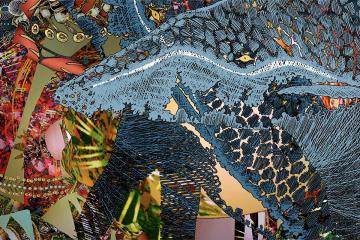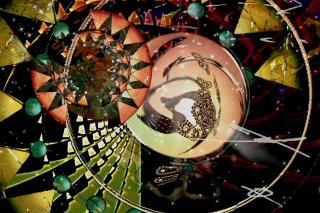Since childhood, Karen LaFleur ’97MA has been creating other worlds.
“When I was 6 years old, I would build these little villages [from shells and twigs] on the beach and hide them in the rocks and dunes, away from the shore. I wanted people to find them, like a mini ecological dig, and wonder: Where did that come from? Who lived there?”
Those worlds, and the stories hidden within them, inspired LaFleur to create in various mediums. “There is always a story behind what I create, even if it’s abstract,” she says.
That love of story drew her to the Simmons Master of Arts in Children’s Literature.
“I credit the Simmons' Children’s Literature program for grounding in me an understanding of how a "story moves the reader" across the page,” says LaFleur. “I wanted to put text and image together. Right from the beginning, I’ve been looking for stories that move, whether through flipping a page or animation. At Simmons, I looked at how a story advances across the page. How do the elements of shape, tone, and color bring the story alive? How does the story get to the next page? Whether you think of animation, a flipbook, or a picturebook, the same rules of story anticipation apply.”
Following the Technology
LaFleur intuited that technology would be crucial to create the moving image art that she envisioned.
“The technology needed to progress enough into a consumer-sized system for me to afford it,” she recalls. “I had the first computer in town in 1981, an Apple IIe. I knew the machine would help me in many different ways.”
While studying at Simmons, LaFleur discovered how technology could help her manage her dyslexia. By photocopying books and altering the presentation of the text, she was able to keep up with the reading requirements for the children’s literature degree. Technology also impacted her art making, and the gallery she ran with her late husband, artist Philip Pieper.
“I would go to technology trade fairs in Boston,” says LaFleur. “Before the internet, this is how you found out what was happening [in tech].” In 1981, she purchased the first iteration of Adobe Photoshop.
“I never went with the pre-packaged art programs,” says LaFleur, who continues to work in Photoshop. “All of my artwork starts with pencil drawing on vellum. Then I take that drawing and put it into Photoshop and capture all of the elements in their own layers. I paint [the layers] in Photoshop. Then each of those elements, with a transparent background, [are moved] into Apple Motion [a motion graphics tool].” In Apple Motion, she animates her images into a visual storyboard and occasionally includes effects she creates with Adobe After Effects, Blender, and Cinema 4D.
She uses Final Cut Pro, a video editing software, to assemble her images with transitions and original music by composer Nancy Tucker.
Some of LaFleur’s recent exhibits include the MoCA L.I.ghts/Light Projection Festival (2023), the Cotuit Center for the Arts Video Wall (2023), the Kingsborough Art Museum in Brooklyn, New York (2024), the Cape Cod Museum of Art (2025), and the G.MAP Media Museum in Gwangju, South Korea (2025).
Techspressionism
LaFleur describes her art as Techspressionism, an art approach that uses technology to express an emotional experience. “It’s akin to Expressionism,” she says, referring to the modernist movement that focused on personal perspectives and sought to evoke an emotional response.

LaFleur found this art movement by seeking out artists using technology. In 2020, she joined one of the first Techspressionism salons, part of an online art community established by artist Colin Goldberg. According to the website, “Techspressionism builds upon a lineage rooted in the Hamptons, where Abstract Expressionists like Jackson Pollock and Lee Krasner lived and worked. Guided by Helen Harrison, a renowned Hamptons-based art historian and former director of the Pollock-Krasner House, Techspressionism has quickly become a global phenomenon, with over 350+ artists from 45 countries and over 80,000 Instagram posts using the hashtag.”
The group holds monthly meetings of key players in technology art. “There is no organization, no hierarchy. Artists show up and share, create, and organize Techspressionism events,” says LaFleur. The gatherings are international, often relying on translation software to enable artists around the globe to contribute. “Art is a conversation, a philosophy as well as a technique, and we engage with artists around the world.”
That online community helps to differentiate Techspressionism as a fine art. “The word ‘digital’ doesn’t do us any service as artists,” says LaFleur. In her experience, digital art is lumped together with animation and video games, whereas LaFleur and her colleagues approach their artwork in a different way. “It helps artists using technology and museums to have a word to describe what we do.”
Projects born of this group are often collaborative and generated by the artists, including an upcoming podcast on The Osiris Munir Show | LA Talk Radio, and a show that premiered this month in Uzbekistan organized by artist Cynthia Beth Rubin. “These artists come together and create a world. One artist may take the lead with an idea while other artists in the community volunteer support. We are helping each other create a global art scene via technology,” says LaFleur, mentioning additional shows in Brooklyn, NY in 2024, and Chelsea, MA in 2025 curated by artist Tommy Mintz.
Also this year, LaFleur was a part of “Four Techspressionist Artists // 150 Media Stream,” a moving image-based public art installation curated by Yuge Zhou at 150 Media Stream in Chicago, Illinois. “We created artwork for a video screen that was 150 feet long and 22 feet high, resulting in a huge 15,360 x 2160 pixel file,” said LaFleur. Her video, “Mycorrhizal,” focused on the “symbiotic relationship between plants and fungi.”
Nature in Art

Finding inspiration from the natural world has been a part of her art from childhood, when she built those tiny worlds on the beach. Since then, scientific observations have further enhanced her work.
“I credit my work with Woods Hole Oceanographic Institution (WHOI) Scientists for demystifying the ocean’s complexities,” says LaFleur. “It has influenced my understanding of the environment.”
Her collaboration with Techspressionist artist Renata Janiszewska, “Mariniana: The Interrupted Wave,” is an example of this art and science combination by (per the description) “illuminating ocean mysteries through myth and science.” For the exhibit, LaFleur worked with WHOI scientist Lukas Taenzer via the ALRI Synergy Project to create a moving image artwork inspired by his studies of “eddies along the edges of ocean water bodies.”
“Art can help scientists bring their studies to the public,” LaFleur says of these collaborations.
Advice for Aspiring Artists
For aspiring artists, LaFleur advises: “Believe in your own talent, believe in your own creative voice. Art isn’t just the object; it’s a language, a philosophy. The [final product] isn’t the point, it’s the [development of the] artist’s voice.”
While the development of that artistic voice requires time and maturity, any artist can follow their own intuition. “[The art] wouldn’t exist if you didn’t create it. You have to figure out what the art wants. We are the medium of the creative spark, the means by which it gets transferred to the page, screen, or 3D object.”
To that end, LaFleur cautions against thinking of the audience while creating art. “If [your work] speaks in its genuine language, it will speak to the people it needs to speak to.”
LaFleur recalls her exhibition “Night Driving,” a collection of sudden fiction embedded in digital paintings. “A visitor wrote in the guest book, ‘You go places I instantly recognize but can’t articulate.’ I don’t know what her story was, but my story spoke genuinely enough that she picked up on it. So be true to your creative voice. The stories change, but the same drive to tell them is always there.”

